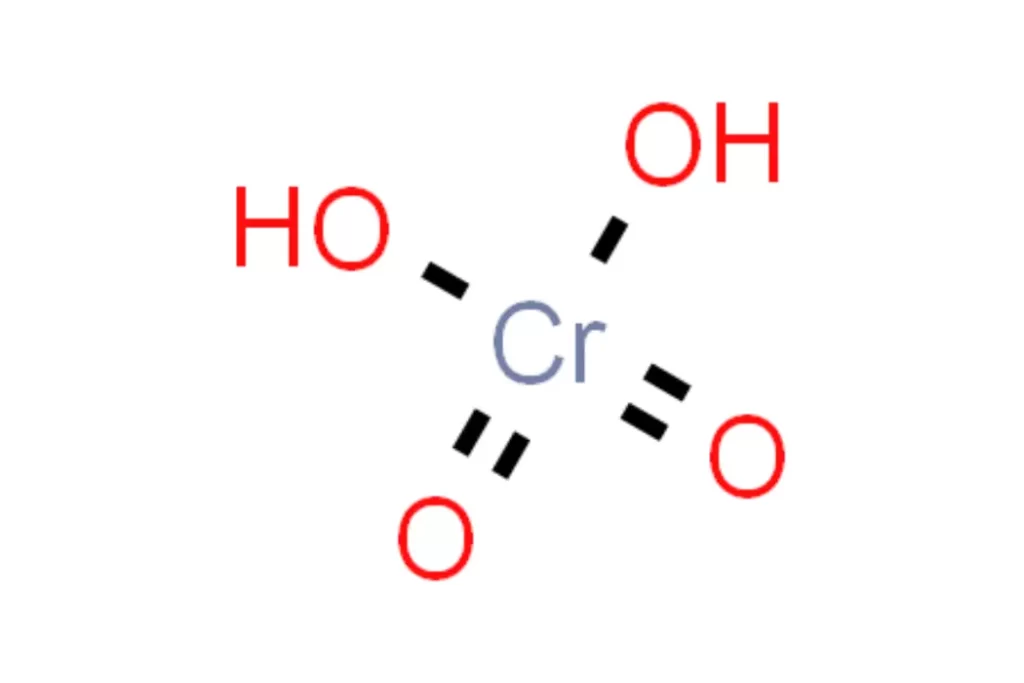In the world of organic chemistry, oxidizing agents play a crucial role in numerous transformations and reactions. Among these agents, chromic acid stands out as one of the most potent and versatile oxidizing agents available to chemists. Chromic Acid in organic chemistry stands as a potent oxidizing agent, serving as a crucial source of knowledge for chemists seeking powerful tools in chemical transformations. This article delves into the realm of chromic acid, exploring its characteristics, mechanisms, applications, advantages, and limitations in the context of organic chemistry.
What is Chromic Acid?
Chromic acid, also known as chromium trioxide (CrO3), is a powerful inorganic compound extensively used as an oxidizing agent in various chemical processes. It is a dark red, hygroscopic solid that is highly soluble in water. When mixed with sulfuric acid (H2SO4), chromic acid becomes even more effective as an oxidizing agent, and this mixture is commonly employed in organic synthesis.

The Role of Chromic Acid as an Oxidizing Agent
Chromium Trioxide and Sulfuric Acid Mixture
The combination of chromium trioxide with sulfuric acid creates a potent oxidizing solution. This mixture can efficiently convert primary and secondary alcohols to aldehydes and ketones, respectively, making it an invaluable tool in alcohol oxidation.
Chromic Acid in Alcohol Oxidation
One of the fundamental applications of chromic acid in organic chemistry is the oxidation of alcohols. By selectively oxidizing the hydroxyl group of alcohols, chemists can obtain various carbonyl compounds, which are essential intermediates in numerous synthetic pathways.
Chromic Acid in Ketone and Aldehyde Oxidation
Chromic acid plays a crucial role in converting aldehydes to carboxylic acids and secondary alcohols to ketones. This process is of great importance in the synthesis of organic molecules with specific functional groups.
Chromic Acid in Organic Synthesis
The ability of chromic acid to introduce oxygen atoms into organic molecules has led to its widespread use in organic synthesis. It is employed to synthesize various compounds, including aldehydes, ketones, and carboxylic acids.
The Mechanism of Oxidation
Formation of Chromate Ester
The oxidation process begins with the formation of a chromate ester intermediate. This intermediate is crucial for the transfer of oxygen to the substrate.
Transfer of Oxygen
Once the chromate ester is formed, it facilitates the transfer of oxygen to the organic substrate, leading to the desired oxidation reaction.
Regeneration of Chromium Trioxide
After the oxygen transfer, the chromium trioxide is regenerated, allowing it to participate in further oxidation reactions.
Advantages and Limitations of Using Chromic Acid
Advantages
Chromic acid offers several advantages as an oxidizing agent. It is highly effective, selective, and readily available. Moreover, it can be easily handled and stored when in the form of a mixture with sulfuric acid.
Limitations
Despite its usefulness, chromic acid has some limitations. It is a toxic and hazardous compound, requiring careful handling and disposal. Additionally, in certain cases, it may lead to over-oxidation and the formation of unwanted by-products.
Safety Considerations when Handling Chromic Acid
When working with chromic acid, safety must be a top priority. Proper personal protective equipment (PPE) and lab practices should be followed to avoid any accidents or exposure.
Alternative Oxidizing Agents in Organic Chemistry
As the quest for greener and more sustainable practices continues, chemists have explored alternative oxidizing agents that offer comparable efficacy without the same level of toxicity.
Potassium Dichromate
Potassium dichromate is a milder oxidizing agent that can replace chromic acid in certain reactions, particularly in the presence of alcohols.
Manganese Dioxide
Manganese dioxide is another alternative oxidant used in organic chemistry, especially for the oxidation of primary alcohols.
Jones Reagent
The Jones reagent, a solution of chromium trioxide in sulfuric acid, is a safer substitute for pure chromic acid, making it a popular choice in laboratories.
Green Chemistry Perspectives
With an increasing emphasis on sustainability and environmental impact, the field of green chemistry aims to find greener alternatives to traditional chemical processes. Utilizing alternative oxidizing agents and exploring more eco-friendly methodologies are essential steps toward a more sustainable future for organic chemistry.
Applications of Chromic Acid in Real-Life Scenarios
Pharmaceutical Industry
Chromic acid finds extensive use in the pharmaceutical industry for synthesizing key intermediates and active pharmaceutical ingredients (APIs).
Production of Fine Chemicals
The chemical industry also relies on chromic acid for the production of fine chemicals, including fragrances, dyes, and specialty compounds.
Future of Chromic Acid in Organic Chemistry
While the use of chromic acid remains prevalent today, ongoing research in green chemistry may lead to the discovery of even more sustainable and efficient oxidizing agents in the future.
Conclusion
Chromic acid, as an oxidizing agent, has significantly contributed to the advancements in organic chemistry. Its versatility and efficacy in various oxidation reactions make it an invaluable tool for synthetic chemists. However, its toxic nature necessitates careful handling and consideration of greener alternatives. As the field of green chemistry continues to evolve, it holds the promise of presenting more sustainable options for oxidation processes, ensuring a safer and more environmentally friendly approach to organic chemistry.
FAQs
What is Chromic Acid?
Chromic Acid, also known as chromium trioxide (CrO3), is a powerful inorganic compound used as a potent oxidizing agent in organic chemistry.
How is Chromic Acid commonly used in organic chemistry?
Chromic Acid is commonly used in organic chemistry for the oxidation of alcohols to aldehydes and ketones, as well as in the synthesis of various organic compounds.
Is Chromic Acid hazardous to handle?
Yes, Chromic Acid is hazardous and requires careful handling due to its toxic nature. Proper safety measures should be followed when working with this chemical.
What are the advantages of using Chromic Acid as an oxidizing agent?
Chromic Acid offers high efficacy, selectivity, and availability, making it a preferred choice for certain oxidation reactions in organic synthesis.


